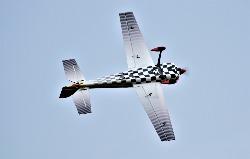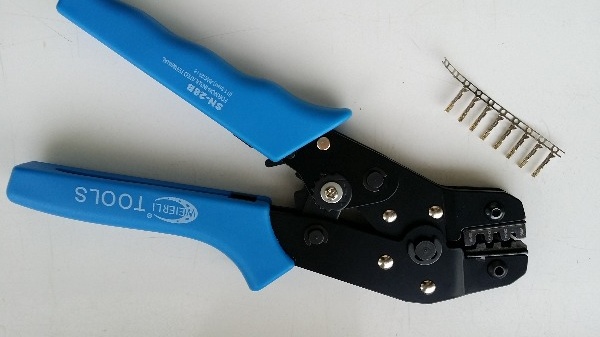- Thank you received: 0
To crimp or not to crimp...
-
 Topic Author
Topic Author
- New Member
-

Less
More
7 years 10 months ago #14985
by
To crimp or not to crimp... was created by
In my vast experience (most of which is questionable) I have yet to find an Aileron servo with the correct length lead attached! This uncomfortable situation inevitably gets resolved by added and extension lead and securing it with heat shrink. On my current project I built the extension lead into the wing, but now I have a lump of plastic and excess wire in the servo area, alas the hole for the servo lead is not big enough for the connector and excess wire to pass through. So I'm thinking of cutting off the offending plastic on both and joining them.
So here's the thing, I've always looked down on crimped connections, believing that soldering has to be better, I have to confess I have no idea when or where I developed my distain for crimps... But I've recently discovered that crimping is actually not a bad method assuming you can make a good job of it.
So I was wondering if you can get crimps for joining wires? Or are they just the purview of the terminal end?
So here's the thing, I've always looked down on crimped connections, believing that soldering has to be better, I have to confess I have no idea when or where I developed my distain for crimps... But I've recently discovered that crimping is actually not a bad method assuming you can make a good job of it.
So I was wondering if you can get crimps for joining wires? Or are they just the purview of the terminal end?
Please Log in or Create an account to join the conversation.
- Chris73
-

- Offline
- Platinum Member
-

Less
More
- Posts: 492
- Thank you received: 83
7 years 10 months ago #14986
by Chris73
Replied by Chris73 on topic To crimp or not to crimp...
What about removing the plastic housing from a normal servo connector, so you are only using the metal pins and a small piece of heat shrink over each pin
If you staggered the joint it wouldn't be much thicker than the cable
If you staggered the joint it wouldn't be much thicker than the cable
Please Log in or Create an account to join the conversation.
- kevinross
-

- Offline
- Platinum Member
-

Less
More
- Posts: 1028
- Thank you received: 583
7 years 10 months ago #14987
by kevinross
Replied by kevinross on topic To crimp or not to crimp...
Although crimped connectors are now the norm in industry (including full size aviation) they do require specific tooling and procedures to provide consistent reliability but can be accomplished by lower skilled people. whereas consistency by soldering requires higher skills. In my opinion neither is more reliable when carried out correctly.
Ive been extending servo leads by soldering extensions between the servo and the original crimped plug for many years and never had a failure. I can't imagine A guy with your skills could not make reliable soldered connections. Whatever your decision, staggering aa Chris 73 suggests makes for a neater less obtrusive join.
Ive been extending servo leads by soldering extensions between the servo and the original crimped plug for many years and never had a failure. I can't imagine A guy with your skills could not make reliable soldered connections. Whatever your decision, staggering aa Chris 73 suggests makes for a neater less obtrusive join.
Please Log in or Create an account to join the conversation.
- DavidTappin
-

- Offline
- Platinum Member
-

Less
More
- Posts: 552
- Thank you received: 164
7 years 10 months ago #14988
by DavidTappin
Replied by DavidTappin on topic To crimp or not to crimp...
Kevin said he'd been
I was just about to post exactly the same comment, customise your cabling this way and end up with exactly what you want and no excess of servo cable to tuck away out of sight to tidy things up. I use a simple soldered lay-on joint with each joint shrink wrapped then the whole cluster of three joints shrink wrapped to provide additional strain relief.soldering extensions between the servo and the original crimped plug for many years and never had a failure
Please Log in or Create an account to join the conversation.
- Phil Ford
-

- Offline
- Administrator
-

Less
More
- Posts: 3163
- Thank you received: 903
7 years 10 months ago - 7 years 10 months ago #14992
by Phil Ford
Replied by Phil Ford on topic To crimp or not to crimp...
Crimping is the norm nowadays albeit clever machines do it quickly and efficiently whereas us humans have to use the hand tool. A bit fiddly and quite few terminals wasted until you attain a sort of mastery of the crimp. :lol: My biggest beef is getting the crimp right but finding the pins has distorted oh so very slightly making it near on impossible to fully insert into the servo plug without meticulous straightening of the pin.
Fortunately the servo plugs whether female or male use a standard 2.5mm pcb spacing (and battery balance leads) which opens up all sorts of possibilities.
Bought a whole roll of 22swg servo wire off Ebay for reasonable money. Many years worth of custom made leads. Pins and plugs from RS.
Fortunately the servo plugs whether female or male use a standard 2.5mm pcb spacing (and battery balance leads) which opens up all sorts of possibilities.
Bought a whole roll of 22swg servo wire off Ebay for reasonable money. Many years worth of custom made leads. Pins and plugs from RS.
Last edit: 7 years 10 months ago by Phil Ford.
Please Log in or Create an account to join the conversation.
-
 Topic Author
Topic Author
- New Member
-

Less
More
- Thank you received: 0
7 years 9 months ago #14994
by
Replied by on topic To crimp or not to crimp...
Thank you, great advice, I'll solder in an extension bit of wire as suggested.
I do have a crimping device similar to the one you show Phil, but I've yet to even do a test crimp with it. On the Atlas each retract ended up with three extension leads and I consider each connection a potential failure point, so I was already gearing up to try and make the next installation much neater with just the right length wires. (I should point out that one of the extensions for the retracts had a voltage regulator in it)
Thanks again
I do have a crimping device similar to the one you show Phil, but I've yet to even do a test crimp with it. On the Atlas each retract ended up with three extension leads and I consider each connection a potential failure point, so I was already gearing up to try and make the next installation much neater with just the right length wires. (I should point out that one of the extensions for the retracts had a voltage regulator in it)
Thanks again
Please Log in or Create an account to join the conversation.
Moderators: DaveBright
Time to create page: 0.254 seconds
Latest Posts
-
-

- Various Gliders from Dave Ambrose ex W.M.A.C Membe...
- In WimborneMac Members / For Sale - Exchange - Wanted
- by 4Pedalsfly
- 1 week 1 day ago
-
-
-

- Ray Ivey's Models
- In WimborneMac Members / For Sale - Exchange - Wanted
- by Phil Ford
- 2 weeks 23 hours ago
-
©
2009 - 2025
WMAC PCF Design

